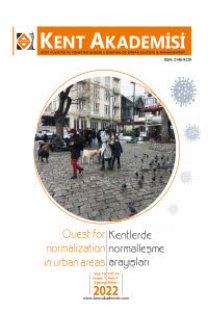İçme Suyu Şebekelerinde Kayıp Kaçak Seviyesinin Belirlenmesi: Merzifon İlçesi Örneği
Su Dengesi, Gelir Getirmeyen Su, Fiziki (gerçek) Kayıplar, Görünür Kayıplar, Altyapı Sızıntı İndeksi
Determining Level of Leakage in Drinking Water Networks: The Case of Mezrifon District
Water Balance, Non-revenue Water, Physical (real) Losses, Apparent losses, Infrastructure Leakage Index,
___
- Aboelnga, H., Saidan, M., Al-Weshah, R., Sturm, M., Ribbe, L., & Frechen, F. B. (2018). Component analysis for optimal leakage management in Madaba, Jordan. Journal of Water Supply: Research and Technology—AQUA, 67(4), 384-396.
- Can, N. (2014). İçme Suyu Şebekelerinde Oluşan Su Kayıplarının Belirlenmesi ve Kontrolü: İstanbul İli Örneği. İstanbul Üniversitesi Fen Bilimleri Enstitüsü.
- Çakmakcı M., Uyak V., Öztürk İ, Aydın A.F., Soyer E. ve Akça L. (2007). The Dimension and Significance of Water Losses in Turkey. In Proceedings of IWA Specialist Conference on Water Loss, Bucharest, Romania,, pp. 464-473.
- Fares, H. and Zayed, T. (2009). Risk assessment for water mains using fuzzy approach. InBuilding a Sustainable Future–Proceedings of the 2009 Construction Research Congress,ASCE, 1125–1134.
- Farley, M. (2001). Leakage Management and Control: A Best Practice Training Manual. WHO, Geneva, Switzerland.
- Farley, M., Wyeth, G., Ghazali, Z. B. M., Istandar, A., and Singh, S. (2008). The Manager’s Non-revenue water handbook. A Guide to Understanding Water Losses.
- Furness, R. (2003). Assessing leakage in water supply networks using flowmeters. Water Eng. Manage. 150 (3), 26–29.
- Gerger, R., ve Aslan, A. (2019). Şanlıurfa İli İçin İçme Suyu Kayıp ve Kaçaklarının Tespiti. Harran Üniversitesi Mühendislik Dergisi, 4(2), 26-35.
- Hardeman, S. (2008). A cost-benefit analysis of leak detection and the potential of real water savings for New Mexico water systems.
- Islam, M. S., Sadiq, R., Rodriguez, M. J., Francisque, A., Najjaran, H., Naser, B. ve Hoorfar, M. (2012). Evaluating leakage potential in water distribution systems: a fuzzy-based methodology. Journal of Water Supply: Research and Technology—AQUA, 61(4), 240-252.
- Kanakoudis, V. ve Muhammetoglu, H.(2014). Urban Water Pipe Networks Management Towards Non‐Revenue Water Reduction: Two Case Studies from Greece and Turkey. CLEAN–Soil, Air, Water, 42(7), 880-892.
- Kanakoudis, V. ve Muhammetoğlu, H. (2014). Gelir getirmeyen suların azaltılmasına yönelik kentsel su borusu şebekelerinin yönetimi: Yunanistan ve Türkiye'den iki örnek olay. CLEAN–Toprak, Hava, Su, 42 (7), 880-892.
- Karadirek, I. E., Kara, S., Yilmaz, G., Muhammetoglu, A., and Muhammetoglu, H. (2012). Implementation of hydraulic modelling for water-loss reduction through pressure management. Water Resources Management, 26(9), 2555-2568.
- Karakuş, C. B., Yıldız, S., ve Cerit, O. (2010). Sivas kent içme suyu şebekesindeki su kayıpları ve kayıp oranını azaltma çalışmaları. Selçuk Üniversitesi Mühendislik, Bilim ve Teknoloji Dergisi, 25(1), 1-10.
- Kızılöz, B. (2021). İçme suyu dağıtım sistemlerinde su kayıplarının azaltılması: Kocaeli örneği.
- Kingdom, W., Liemberger, R. ve Marin P. (2006). The Challenge of Reducing Non- Revenue Water (NRW) in Developing Countries – How the Private Sector Can Help: A Look at Performance-Based Service Contracting, Water Supply and Sanitation Sector Board Discussion Paper Series, Paper No. 8, The World Bank, Washington, DC, 2006, pp. 1–40.
- Körpe, M. (2018). Konya içme suyu şebekesinde su kayıplarının tespiti ve değerlendirilmesi (Master's thesis, Necmettin Erbakan Üniversitesi Fen Bilimleri Enstitüsü).
- Lambert, A. (2002). International report on water losses management and techniques: report to IWA Berlin Congress, October 2001. Water Sci. Technol: Water Supply 2 (4), 1–20.
- Lambert, A. (2003). Assessing non-revenue water and its components: a practical approach. Water21: 50-51.
- Lambert, A. O., Brown, T. G., Takizawa, M., & Weimer, D. (1999). A review of performance indicators for real losses from water supply systems. Journal of Water Supply: Research and Technology—AQUA, 48(6), 227-237.
- Liemberger, R., and McKenzie, R. (2005). Accuracy limitations of the ILI: is it an appropriate indicator for developing countries. In Conference Proceedings, IWA Leakage 2005 Conference in Halifax, Nova Scotia, Canada.
- Muhammetoğlu, H. ve Muhammetoğlu A. (2017). İçme Suyu Temin ve Dağıtım Sistemlerindeki Su Kayıplarının Kontrolü El Kitabı. T.C. Orman ve Su İşleri Bakanlığı Su Yönetimi Genel Müdürlüğü. Kutlu ve Avcı Ofset. Antalya.
- Puust R., Kapelan Z., Savic D. ve Koppel T. (2010). A review of methods for leakage management in pipe networks. Urban Water J 7 (1) 25-45.
- Selek, B., Adıgüzel, A., İritaş, Ö., Karaaslan, Y., Kınacı, C., Muhammetoğlu, A. ve Muhammetoğlu, H. (2018). Management of water losses in water supply and distribution networks in Turkey. Turkish Journal of Water Science and Management, 2(1), 58-75.
- Tabesh, M., Yekta, A. H. A. ve Burrows, R. (2009). An integrated model to evaluate losses in water distribution systems. Water Res. Manage. 23 (3), 477–492.
- TÜİK. (2022). Türkiye İstatistik Kurumu. Erişim Tarihi: 25.03.2022, https://data.tuik.gov.tr
- www.lafsozluk.com Erişim Tarihi: 11.10.2022.
- ISSN: 2146-9229
- Yayın Aralığı: Yılda 4 Sayı
- Başlangıç: 2008
- Yayıncı: Karadeniz Yazarlar ve Şairler Derneği
Manisa Hatuniye Camisi ve 15. ve 16. Yüzyıl Manisa Camileri İçindeki Yerine Yönelik Bir Araştırma
Kentle Diyalog Kuran Alternatif Mekanlar: Köprüler
Arife KOCA, Hatice Günseli DEMİRKOL
Covid-19 Salgını Sürecinde Belediyelerde Sosyal Hizmet Uygulamaları
Türkiye’de Sürdürülebilir Kentleşme: Bir Yapısal Eşitlik Modeli Uyarlaması
Şahika GÖKMEN, Deniz KOÇAK, Murat ATAN
Kırsal Yerleşmelerde Konut Eklentilerinin Bilecik Tongurlar Köyü Üzerinden İrdelenmesi
Didem BARAN ERGÜL, Dilek EKŞİ AKBULUT
Kentleşme ve Göçün Suç Üzerindeki Etkileri: Taşı Toprağı Altın Şehir Filmi Örneği
Emre CENGİZ, Nurefşan ESKİYURT
Gülşen AKIN GÜLER, Aslı ÖZÇEVİK BİLEN
Türkiye’de Konut Hakkı ve Bu Hakkın Kullanılmasında Ortaya Çıkan Sorunlara Yönelik Değerlendirme
Melis KARACA SERT, Yener ALTIPARMAKOĞULLARI, Aysem Gulin BASAR
